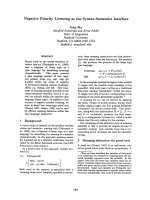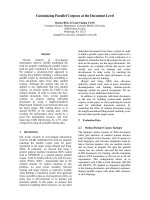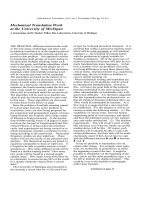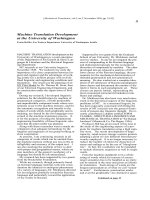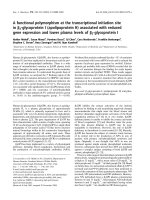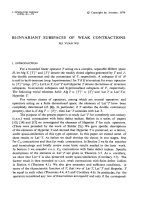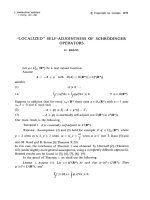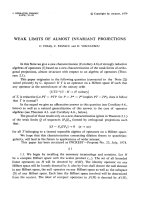Báo cáo toán học: "Catalan Traffic at the Beach" doc
Bạn đang xem bản rút gọn của tài liệu. Xem và tải ngay bản đầy đủ của tài liệu tại đây (154.16 KB, 17 trang )
Catalan Traffic at the Beach
Heinrich Niederhausen
Department of Mathematical Sciences
Florida Atlantic University, Boca Raton, USA
Submitted: March 17, 2002; Accepted: August 12, 2002.
MR Subject Classifications: 05A15, 05A19
Abstract
The ubiquitous Catalan numbers C
n
=
2n
n
/ (n + 1) occur as t (n, −n)inthe
following table showing the number of ways to reach the point (n, m) on a rectan-
gular grid under certain traffic restrictions, indicated by arrows.
m
1
↑
→ 3
↑
→ 6
↑
→ 9
↑
→ 12
↑
→ 12
↑
→ 12
↑
↓
→
gate
2 1
↑
→ 2
↑
→ 3
↑
→ 3
↑
→ 3
↑
↓
→
gate
12
↓
→
1 1
↑
→ 1
↑
→ 1
↑
↓
→
gate
3
↓
→
3
↓
→
12
↓
→
start here 1
↑
→
gate
1
↓
→
1
↓
→
3
↓
→
6
↓
→
15
↓
→
−1 ≈ 1 →
1
↓
→
2
↓
→
4
↓
→
9
↓
→
21
↓
→
−2 ≈≈2 →
3
↓
→
6
↓
→
13
↓
→
30
↓
→
−3 ≈≈≈5 →
9
↓
→
19
↓
→
43
↓
→
−4 ≈ t (n, m) ≈ 14 →
28
↓
→
62
↓
→
−5 ≈≈≈≈≈42 →
90
↓
→
0 123 4 5 n
We prove this with the help of hypergeometric identities, and also by solving an
equivalent lattice path problem. On the way we pick up several identities and discuss
other known sequences of numbers occurring in the Catalan traffic scheme, like the
Motzkin numbers in row m = −1, and the “Tri-Catalan numbers” 1, 1, 3, 12, 55,
at the gates.
1 Catalan Traffic
There are 66 problems in Stanley’s book Enumerative Combinatorics, Vol. II [10, Chpt.
6], about different combinatorial structures counted by the Catalan numbers C
i
=
1
i+1
2i
i
.
One example (Ballot problem, or Dyck paths) is the total count of lattice paths with step
vectors East (→) and South (↓), starting at the origin, ending on the diagonal y + x =0,
never going below that line. If we think of the lattice as the streets on a city map, the
diagonal as the beach, we are talking about the number of shortest trips between two
spots at the beach.
the electronic journal of combinatorics 9 (2002), #R33 1
start here 1
→
1
→
↓
1
→
↓
1
→
↓
1
→
↓
1
→
↓
≈ 1
→
2
→
↓
3
→
↓
4
→
↓
5
→
↓
≈≈2
→
5
→
↓
9
→
↓
14
→
↓
≈≈≈5
→
14
→
↓
28
→
↓
≈≈≈≈14
→
42
→
↓
≈≈≈≈ ≈42
→
Table 1: The number of routes from the starting point to any other point on the beach
are the Catalan numbers
We will prove that the following obstacle course, a carefully designed system of detours
and right turns, again allows us to visit the diagonal in the same (Catalan-) number of
ways as before, with the added benefit that we cannot get off the diagonal anymore.
m
1
↑
→ 3
↑
→ 6
↑
→ 9
↑
→ 12
↑
→ 12
↑
→ 12
↑
↓
→
gate
2 1
↑
→ 2
↑
→ 3
↑
→ 3
↑
→ 3
↑
↓
→
gate
12
↓
→
1 1
↑
→ 1
↑
→ 1
↑
↓
→
gate
3
↓
→
3
↓
→
12
↓
→
start here 1
↑
→
gate
1
↓
→
1
↓
→
3
↓
→
6
↓
→
15
↓
→
−1 ≈ 1 →
1
↓
→
2
↓
→
4
↓
→
9
↓
→
21
↓
→
−2 ≈≈2 →
3
↓
→
6
↓
→
13
↓
→
30
↓
→
−3 ≈≈≈5 →
9
↓
→
19
↓
→
43
↓
→
−4 ≈ t (n, m) ≈ 14 →
28
↓
→
62
↓
→
−5 ≈≈≈≈ ≈42 →
90
↓
→
012345n
Table 2: Detours preserving Catalan traffic
The rules are as follows.
1. At lattice points strictly above the line x =2y go N or E (↑ and →).
2. At lattice points strictly below the line x =2y go S and E, but enforce right turns
when coming from the West. Note that such a right turn from (i, j)to(i +1,j− 1)
via (i +1,j) is equivalent to a SE diagonal step . We could simply require that
the step vectors are ↓ and .
3. Block out all traffic at the intersections (2m +1,m), except for right turns for paths
from the West.
4. On the line, at the gates (2m, m), allow N,S, and right turn steps (because of the
road block at (2m +1,m) these steps are equivalent to ↓, ↑,and). The points on
this line are the only gates from the upper traffic to the lower traffic.
Catalan traffic generates other known number sequences besides the Catalan numbers.
As R. Sulanke pointed out to me, the sequence t (n, −1), n ≥ 1, must be the sequence of
the electronic journal of combinatorics 9 (2002), #R33 2
m 1
↑
→ 3
↑
→ 6
↑
→ 9
↑
→ 12
↑
→ 12
↑
→ 12
↑
↓
2 1
↑
→ 2
↑
→ 3
↑
→ 3
↑
→ 3
↑
↓
0 12
↓
1 1
↑
→ 1
↑
→ 1
↑
↓
0 3
↓
3
↓
12
↓
0 1
↑
0 1
↓
1
↓
3
↓
6
↓
15
↓
−1 1
1
↓
2
↓
4
↓
9
↓
21
↓
−2 2
3
↓
6
↓
13
↓
30
↓
−3 5
9
↓
19
↓
43
↓
−4 t (n, m)14
28
↓
62
↓
−5 42
90
↓
0123 45 6
Table 3: Diagonal steps can replace the right turns (gates in bold)
Motzkin numbers if t (n, −n)=C
n
. In addition, the numbers at the gates are also well
known,
3i
i
/ (2i + 1); they may be viewed as the “Tri-Catalan numbers” C
n
in the family
cn
n
/ ((c − 1) n + 1) of Catalans. For references see the sequence A001764 in the On-Line
Encyclopedia of Integer Sequences. They were the original motivation for devising the
Catalan traffic when I was introduced to them in the form of a tennis ball sequence by
Merlini, Sprugnoli, R., and Verri, M. C. [5]. Some of this additional material is compiled
in Section 5. The three types of numbers that occur in the Catalan traffic scheme are
summarized in the following table.
Number a
n
Formula Gen. Function
∞
n=0
a
n
t
n
Location
Catalan C
n
2n
n
/ (n +1)
2
1+
√
1−4t
t (n, −n)
Tri-Catalan C
n
3n
n
/ (2n +1)
2
√
3t
sin
1
3
arcsin
√
27t/2
t (2n, n)
Motzkin M
n
1
n+1
n
k=0
k
n−k
n+1
k
1
2t
2
1 − t −
(1 − 3t)(1+t)
t (n +1, −1)
Table 4: Interesting numbers occuring in the Catalan traffic scheme
To prove that the numbers t (n, −n) along the diagonal really are the Catalan num-
bers we will first reformulate the problem such that the same backwards difference recur-
sion holds at every lattice point. Subsequently we give three proofs for the observation
t (n, −n)=C
n
. The first pair of proofs show that the following system of equations
0=
2n−1
i=0
x
i
3n − 2
2n − 1 − i
and 0 =
2n
i=0
x
i
3n − 1
2n − i
is (uniquely) solved by x
i
=(−1)
i
C
i−1
for i>0, and x
0
= 1. The first (and shortest)
proof, Section 3.1, employs the help of Zeilberger’s algorithm for hypergeometric functions
to show that
2
F
1
−m, −
1
2
; m/2;4
= 3 for positive integers m. The second proof,
Section 3.2, is also based on recursive evaluations of hypergeometric functions, offering
the electronic journal of combinatorics 9 (2002), #R33 3
more background material in the form of related identities (Corollary 3), like
C
n
=
1
2n
2n−1
i=0
(−1)
i
C
i
3n
2n − 1 − i
,C
n
=
1
n +1
2n
i=0
(−1)
i
C
i
3n
2n − i
.
drawn from H.W. Gould’s Improved evaluation of the finite hypergeometric series
F (−n, 1/2; j + 1) [2] (Section 3.2). The third proof, in Section 4, is based on the known
solution to the enumeration of lattice paths strictly above lines of slope 2. Combining the
results of these different proofs establishes identities like
m−n/2
i=0
2(m − i) − n
i
(−1)
i
2(m − i)+1
3(m − i)
2m
=
m + n
n
−
n−1
i=0
(−1)
i
C
i
m + n
n − 1 − i
n−1
i=0
(−1)
i
C
i
m + n
n − 1 − i
=(−1)
n
(n−1)/2
i=0
C
i
i − m − 1
n − 1 − 2i
for m ≥ (n − 1) /2 (expansions (17) and (7)),
n/2
i=0
C
i
n + i
3i
=
1
n +1
n/2
i=0
n +1
2i +1
n + i
i
= C
n
(expansion (18)), and
sin
1
3
arcsin
t
2
1 − t
3
−3/2
=
t
3/ (1 − t)
1+
(1 − 4t)
.
First, however, we transform the Catalan traffic at the beach into a problem about lattice
paths with steps →, ↑ strictly above the line y =(x − 1) /2 (Section 3.1), where the
Catalan numbers occur again along the same diagonal, but with alternating signs. They
will also occur when we count →, ↑-paths strictly above the line y = x/2. Such paths
have been enumerated by Gessel [1] with his probabilistic approach. This and another
approach valid for slopes of the form 1/g,whereg is a positive integer, are discussed in
Section 5.
2 Untangling the Detours
The numbers t (n, m) in Table 3 can be recursively calculated from the given initial con-
ditions. However, two simple changes will make the recursive calculations easier. In the
first step we split the “gates” at (2m, m) into two cells, (2m, m)and(2m +1,m−1),
duplicating the content, and shifting the whole matrix of numbers below the line 2y = x
one step SE. Call the new entries t
(n, m). We have t
(n, m)=t (n, m)ifn ≤ 2m,
t
(n, m)=t (n − 1,m+1)ifn ≥ 2m+3, and we fill the crack with zeroes, t (2m +1,m):=
t (2m +2,m) := 0 for all m ≥ 0. From the “new points” (2m, m), (2m +1,m), and
the electronic journal of combinatorics 9 (2002), #R33 4
Stretching the lattice (the crack in brackets) Changing signs
m 1
↑
→ 3
↑
→ 6
↑
→ 9
↑
→ 12
↑
→ 12
↑
→ 1 3 6 9 12 12 12
2 1
↑
→ 2
↑
→ 3
↑
→ 3
↑
→ 3
↑
[0]
↓
12 33 3 0 0
1 1
↑
→ 1
↑
→ 1
↑
→ [0]
↓
[0]
↓
3
↓
11 10 0 −30
0 1
↑
[0]
↓
[0]
↓
1
↓
0
↓
3
↓
10 0−10 −33
−1 1
0
↓
1
↓
1
↓
3
↓
−10−11 −33
−2 1
1
↓
2
↓
4
↓
1 −12 −49
−3 2
3
↓
6
↓
−23 −613
−4 t
(n, m)5
9
↓
d(n, m)5−919
−5 14
−14 28
012345 01 23 4 5 n
Table 5: Unifying the recursion
(2m +2,m) the path can take the steps and ↓. The conjectured n-th Catalan number
C
n
has moved down the diagonal to the position (n +1, −n − 1).
In the second step we change the sign of the entries in odd numbered columns, but
only below the crack; call the new values d (n, m). We have d (n, m)=(−1)
n
t
(n, m)if
n ≥ 2m +2,andd (n, m)=t
(n, m)ifn ≤ 2m + 1. We claim that
d (n, m)=d (n, m − 1) + d (n − 1,m)(1)
for all m ≥−n. This trivially holds for n ≤ 2m + 2, because it was already true for
t (n, m), and we filled the crack with the right values. If n ≥ 2m +2 andn ≥−m then
d (n, m)=(−1)
n
t
(n, m)=(−1)
n
(t
(n, m +1)+t
(n − 1,m+1))
= d (n, m +1)− d (n − 1,m+1)
confirming (1). Our conjecture about the Catalan numbers in Table 2, t (n, −n)=C
n
,is
equivalent to the conjecture
d (n +1, −n − 1) = (−1)
n+1
C
n
(2)
for all n ≥ 0. We prove this statement in two different approaches. The first proof, in
Section 3, shows that d (n +1, −n − 1) = (−1)
n+1
C
n
are the unique solutions of a system
of equations associated to our problem. We solve the system in two ways, with and without
the help of algebraic computer packages. The second proof interprets the numbers d (n, m)
above the crack as the number of lattice paths from the origin to (n, m) strictly above the
line y =(x −1) /2. These numbers are known; their polynomial expansion shows that
(2) holds.
Because of the simple recursion and initial values, there must be many other proofs
of (2). However, the challenge is finding a combinatorial argument for the appearance of
the nonalternating Catalan numbers t (n, −n)=C
n
in the original problem.
the electronic journal of combinatorics 9 (2002), #R33 5
3 The Hypergeometric Function Approach
The recursion (1) is a backwards difference recursion, d (n, m)−d (n, m − 1) = d (n − 1,m),
with initial values d (0, 0)=1
d (n, (n − 1) /2) = 0 for all odd n>0(3)
d
n,
n
2
− 1
= 0 for all even n>1.
Because we can extend d (0,m) to the constant 1 for all m ∈
,wecanextendd (n, m)
to a polynomial d
n
(x)ofdegreen such that d
n
(m)=d (n, m) for all m ≥−n.
m
1 3 6 9 12 12 12 0
2
123 3300−12
1
1110 0−30−12
0
10 0−10 −33−12
−1
1 −1 0 −11 −36−15
−2
1 −2 1 −12 −49−21
−3
1 −33−2 3 −613−30
−4
1 −46−5 5 −919−43
−5
1 −510−11 10 −14 28 −62
012 3456n
Table 6: The polynomial extension d
n
(m)ofd(n, m)
Any polynomial sequence (s
n
(x))
n≥0
that satisfies the backwards difference equation
s
n
(x) − s
n
(x − 1) = s
n−1
(x) can be expanded as
s
n
(x)=
n
i=0
s
i
(ui + v)
x − un − v
x − ui − v
n − i − 1+x − ui − v
n − i
(4)
for any choice of the scalars u and v [7, Corollary 2.3]. Apply this expansion to the case
u = −1andv =0toseethat
d
n
(x)=
n
i=0
d
i
(−i)
n + x
n − i
. (5)
The initial values (3) imply that for all positive integers n
0=
2n−1
i=0
d
i
(−i)
3n − 2
2n − 1 − i
and 0 =
2n
i=0
d
i
(−i)
3n − 1
2n − i
. (6)
This is a system of equations for the unknown coefficients d
i
(−i). The following proposi-
tion shows that d
i
(−i)=(−1)
i
C
i−1
are the unique solutions to the system if d
0
(0) = 1.
This proves statement (2). Expansion (5) will then imply that
d
n
(x)=
x + n
n
+
n
j=1
(−1)
j
C
j−1
x + n
n − j
, (7)
the electronic journal of combinatorics 9 (2002), #R33 6
hence we obtain the generating function
n≥0
d
n
(x) t
n
=
3
√
1 − t −
√
1+3t
2(1− t)
x+3/2
. (8)
Proposition 1 For positive integers n holds
0=
3n − 2
2n − 1
+
2n−1
i=1
(−1)
i
i
2i − 2
i − 1
3n − 2
2n − 1 − i
and (9)
0=
3n − 1
2n
+
2n
i=1
(−1)
i
i
2i − 2
i − 1
3n − 1
2n − i
. (10)
Equivalently,
2
F
1
[−2n +1, −1/2; n;4]=
2
F
1
[−2n, −1/2; n;4]= 3. (11)
Recall that
2
F
1
[a, b; c; z]=1+
i≥1
a(a+1)···(a+i−1)·b(b+1)···(b+i−1)
i! c(c+1)···(c+i−1)
z
i
. See Subsections 3.1
and 3.2 for two different proofs of the proposition.
3.1 Proof by Zeilberger’s algorithm
Let f (n)=
2
F
1
[−2n, −1/2; n;4] and g (n)=
2
F
1
[−2n +1, −1/2; n; 4]. Zeilberger’s algo-
rithm as implemented in Maple VII shows that
f (n)=
2(9n
2
− 18n + 10) f (n − 1) − 9(n − 1) (n − 2) f (n − 2)
(3n − 1) (3n − 2)
and
g (n)=
2(9n
2
− 27n + 22) g (n − 1) − 9(n − 2)
2
g (n − 2)
(3n − 2) (3n − 4)
.
Both recursions are solved by constant functions. It is easy to check that f (1) = g (1) = 3,
hence f (n)=g (n) = 3 for all positive integers n. This proves Proposition 1 in the form
of equation (11).
3.2 Proof by Gould’s special hypergeometric function
H.W. Gould [2] investigated the hypergeometric function
2
F
1
[−n, 1/2; m;4z] for integers
m and positive integers n. Gould found integral representations and recursions involving
2
F
1
[−2n, 1/2; m;4] and F [−2n +1, 1/2; m; 4]. Important for this paper are his evalua-
tions of the special cases [3, (7.33)-(7.35),(7.40)-(7.42)]
2
F
1
[−2n, 1/2; n;4]=3,
2
F
1
[−2n +1, 1/2; n +1;4]=0, (12)
2
F
1
[−2n +1, 1/2; n;4]=−1
2
F
1
[−2n, 1/2; n +2;4]=
n +1
2n +1
, (13)
2
F
1
[−2n, 1/2; n +1;4]=1,
2
F
1
[−2n +1, 1/2; n +2;4]=
n +1
2(2n +1)
. (14)
We also need the following technical lemma.
the electronic journal of combinatorics 9 (2002), #R33 7
Lemma 2 Let n and m be integers, n>0 and m =0. Then
2
F
1
[−n, −1/2; m;4z]=
2
F
1
[−n, 1/2; m;4z]+
4nz
m
2
F
1
[−n +1, 1/2; m +1;4z] .
With the help of this Lemma and Gould’s special values (12), (13) we prove Proposition
1 in the form of the identities (11),
2
F
1
[−2n, −1/2; n;4]=
2
F
1
[−2n, 1/2; n;4]+
8n
n
2
F
1
[−2n +1, 1/2; n +1;4]=3+0
(15)
2
F
1
[−2n +1, −1/2; n;4]=
2
F
1
[−2n +1, 1/2; n;4]+
4(2n − 1)
n
2
F
1
[−2n +2, 1/2; n +1;4]
= −1+4.
There are many companions to the the pair of identities in Proposition 1. We prove one
example.
Corollary 3 For positive integers n holds
3n
2n +1
=
1
2
2n−1
i=0
(−1)
i
C
i
3n
2n − 1 − i
,
n +1
n
3n
2n +1
=
2n
i=0
(−1)
i
C
i
3n
2n − i
.
Proof. The special values (14) show that
1+
4n
2n+1
=1+
8n
n+1
n+1
2(2n+1)
=
2
F
1
[−2n, 1/2; n +1;4]+
8n
n+1
2
F
1
[−2n +1, 1/2; n +2;4].
By Lemma 2
1+
4n
2n+1
=
2
F
1
[−2n, −1/2; n +1;4]=
2n
j=0
(−1/2)
j
2
2j
j!
(−2n)
j
(n+1)
j
=1−2
2n
j=1
(2j−2)!(−2n)
j
j!(j−1)!(n+1)
j
thus
0=2
3n
2n +1
−
2n−1
j=0
(−1)
j
j +1
2j
j
3n
2n − 1 − j
.
This identity together with
3n−2
2n−1
=
2n−2
i=0
(−1)
i
C
i
3n−2
2n−2−i
(see Proposition 1) imply
that
n +1
n
3n
2n +1
=
3n +1
2n +1
− 2
3n
2n +1
=
2n
i=0
(−1)
i
i +1
2i
i
3n
2n − i
.
4 The Lattice Path Approach
Let D
(n,m)
y=(x−c)/g
be the number of → , ↑-paths strictly above y =(x −c) /g from the ori-
gin to (n, m), where c is any non-negative integer. The untangled detours (Table 5)
show that d (n, m)=D
(n,m)
y=(x−1)/2
. Because classical lattice path enumeration usually con-
siders paths above lines of integer slope, we use two bijections on →, ↑-paths to find
the electronic journal of combinatorics 9 (2002), #R33 8
D
(n,m)
y=(x−c)/g
. Going backwards, from the end to (0, 0), through any path strictly above
y =(x − c) /g to (n, d +(n − c) /g) yields a unique path strictly below y = d + x/g, again
to (n, d +(n − c) /g), and vice versa (note that d +(n − c) /g must be an integer). The
second bijection reflects this new path at the diagonal y = x onto a path strictly above
y = g (x − d), ending at (d +(n − c) /g, n).
D
(n,m)
y=(x−1)/2
(# paths to (6, 5)) D
(n,m)
y=2x−5
(# paths to (5, 6))
m
5 1 5 15 34 65 108 163
4 1 4 10 19 31 43 55
3
1 3 6 9 12 12 12
2
123330 0
1
11 1 0 0
0
10 0
012345 n
m 1 7 28 80 163 163
5 1 6 21 52 83 0
4
1 5 15 31 31
3
1 4 10 16 0
2
1366
1
1230
0
11 1
0123 4 5 n
Table 7: Two different lattice path problems arriving at the same number
The result is a path above a line with positive integer slope g, and we have established
that D
(n,d+(n−c)/g)
y=(x−c)/g
= D
(d+(n−c)/g,n)
y=g(x−d)
. The number of paths above a line with positive integer
slope is well known to be
D
(m,n)
y=g(x−d)
=
d
i=0
i + g (i − d)
i
n − g (m − d)
n − g (i − d)
m − i − 1+n − g (i − d)
m − i
=
m + n
m
−
m
i=d+1
i + g (i − d)
i
n − g (m − d)
n − g (i − d)
m − i − 1+n − g (i − d)
m − i
for m ≥ g (m − d) (for references see Koroljuk [4] or Mohanty [6]. The result also follows
from (4), with u = g, v = −gd,ands
i
(ui + v)=
i+g(i−d)
i
for i =0≤ i ≤ d,and
s
i
(ui + v)=0fori>d). In honor of Koroljuk’s work we will also give a combinatorial
proof of the formula for D
(n,m)
y=(x−c)/g
using his method at the end of this paper, in Proposition
4.
We just saw that D
(m,n)
y=2(x−m+(n−1)/2)
= D
(n,m)
y=(x−1)/2
= d (n, m), and therefore
d (n, m)=
m−(n−1)/2
i=0
3i − 2m + n − 1
i
1
2(m − i)+1
3(m − i)
m − i
(17)
=
m + n
m
−
(n−1)/2
i=0
C
i
m − 3i − 1+n
m − i
=
m + n
n
− (−1)
n−1
(n−1)/2
i=0
C
i
i − m − 1
n − 1 − 2i
the electronic journal of combinatorics 9 (2002), #R33 9
for m ≥ (n − 1) /2 (remember that C
i
=
3i
i
/ (2i + 1), the Tri-Catalan numbers). Spe-
cial values, like 2m = n − 1, will confirm some of the identities in Corollary 3. The last
of the three expansions of d (n, m) in (17) confirms that d (n, m) is a polynomial in m of
degree n. Hence for n ≥ 1weobtaind (n, −n)=
(−1)
n
(n−1)/2
i=0
n − 1+i
3i
1
2i +1
3i
i
=
(−1)
n
n
(n−1)/2
i=0
n
2i +1
n + i − 1
i
. (18)
We can finish this lattice path proof of d (n, −n)=(−1)
n
C
n−1
by showing that the latter
sum equals
2n−2
n−1
(see [3, (3.169)]), but it is also instructive to compare the generating
functions. First notice that
∞
n=0
n+3i
3i
t
n
=(1− t)
−3i−1
and
∞
i=0
C
i
t
i
=
∞
i=0
1
2i +1
3i
i
t
i
=
2
F
1
1
3
,
2
3
;
3
2
;
27
4
t
=
3sin
1
3
arcsin
√
27t/2
√
27t/2
.
Thus
∞
n=1
t
n−1
(−1)
n
d (n, −n)=
∞
i=0
C
i
∞
n=2i+1
t
n−1
n − 1+i
3i
=
∞
i=0
C
i
t
2i
(1 − t)
−3i−1
=
1
1 − t
2
F
1
1
3
,
2
3
;
3
2
; U
2
=
3sin
1
3
arcsin U
(1 − t) U
where U =
3
2
3t
2
/ (1 − t)
3
. We can ‘eliminate’ the 1/3 in front of the arcsin by finding a θ
such that sin 3θ = U. Define θ such that sin θ = U (1 −t)
1 −
√
1 − 4t
/ (6t). Applying
the triple-angle formula sin 3θ =3sinθ − 4sin
3
θ shows that indeed sin 3θ = U. Hence
∞
n=1
t
n−1
(−1)
n
d (n, −n)=
3sin(θ)
(1 − t) U
=
3(1−t)
(1 − t)6t
1 −
√
1 − 4t
=
1 −
√
1 − 4t
2t
=
2
1+
√
1 − 4t
=
n≥0
C
n
t
n
,
the well-known generating function of the Catalan numbers (I thank the referee for short-
ening the derivation by means of the triple-angle formula). We will have another look at
this generating function identity in Section 5.3.
5 Some Remarks on Paths above a Fractional Slope
There are more types of known number sequences occurring in the Catalan traffic scheme
than just the Catalan numbers, and there are other lattice path problems restricted by a
boundary line of slope 1/2 where the alternating Catalan numbers play a role. A short
discussion follows in the next two subsections. Finally, we finish with a glimpse at the
enumeration of lattice paths above a line of fractional slope.
the electronic journal of combinatorics 9 (2002), #R33 10
5.1 Other types of numbers generated by Catalan traffic
m 1
↑
→ 3
↑
→ 6
↑
→ 9
↑
→ 12
↑
→ 12
↑
→
C
3
=12 ↑
↓
→
gate
2 1
↑
→ 2
↑
→ 3
↑
→ 3
↑
→
C
2
=3 ↑
↓
→
gate
12
↓
→
1 1
↑
→ 1
↑
→
C
1
=1 ↑
↓
→
gate
3
↓
→
3
↓
→
12
↓
→
0
↑
C
0
=1
→
gate
1
↓
→
1
↓
→
3
↓
→
6
↓
→
15
↓
→
−1
M
0
=1
→
M
1
=1
↓
→
M
2
=2
↓
→
M
3
=4
↓
→
M
4
=9
↓
→
M
5
=21
↓
→
t (n, m)
0 1 23 45 n
Table 8: Motzkin and Tri-Catalan numbers in the Catalan traffic table
Formulas (7) and (17) are simple expressions for the number D
(n,m)
y=(x−1)/2
of →, ↑-lattice
paths from the origin to (n, m) staying strictly above the boundary y =(x −1) /2,
D
(n,m)
y=(x−1)/2
= d (n, m)=
m + n
n
−
n−1
j=0
(−1)
j
C
j
m + n
n − 1 − j
(19)
=
m + n
m
+(−1)
n
(n−1)/2
i=0
C
i
i − m − 1
n − 1 − 2i
for all n ≤ 2m+1, and also for the polynomial extension to other values of m (again, we use
the abbreviation C
i
=
3i
i
/ (2i + 1)). It is now easy to prove that the Motzkin numbers
M
n
=
1
n+1
n
k=0
k
n−k
n+1
k
occur as t (n − 1, −1) in the Catalan traffic Table 2, and
equivalently as (−1)
n
d (n +2, −2) in Table 6. To check this, note that
n≥0
d
n
(−2) t
n
=
3(1− t) −
√
1+2t − 3t
2
/2, a special case of the generating function
n≥0
d
n
(x) t
n
=
3
√
1 − t −
√
1+3t
(1 − t)
−x−3/2
/2 (see (8)). Hence
n≥2
(−1)
n−1
d
n
(−2) t
n−2
= t
−2
1 − t −
(1 − 3t)(1+t)
/2,
the generating function of the Motzkin numbers.
We can apply the expansion d
n
(x)=
n
i=0
d
i
(ui + v)
x−un−v
x−ui−v
n−i−1+x−ui−v
n−i
(see (4))
to express the numbers d (n, m) in terms of the Motzkin numbers,
d (n, m)=
n
i=0
d
i
(−2)
n − i +1+m
n − i
=
n +1+m
n
− 2
n + m
n − 1
+
n−2
i=0
d
i+2
(−2)
n − i − 1+m
n − 2 − i
=
m − n +1
m +1
n + m
n
+
n−2
i=0
(−1)
i
M
i
n − i − 1+m
n − 2 − i
. (20)
the electronic journal of combinatorics 9 (2002), #R33 11
The numbers at the gates in Table 2, or d (2m, m) in Table 6, are the Tri-Catalan numbers
C
m
; this follows from (19) and the first identity in Corollary 3,
d (2m, m)=
3m
m
−
2m−1
j=0
(−1)
j
C
j
3m
2m − 1 − j
=
3m
m
− 2
3m
2m +1
=
1
2m +1
3m
m
= C
m
.
In the following table we summarize the inverse relationships (in the sense of Riordan [9,
Chpt. 2]) between the three types of numbers, Catalan, Motzkin, and Tri-Catalan, using
(19), (20), and Corollary 3.
C
n
=(−1)
n+1
d
n+1
(−n − 1) =
n/2
i=0
C
i
i + n
n − 2i
=
n−1
i=0
M
i
n − 1
n − 1 − i
M
n
=(−1)
n
d (n +2, −2) =
(n+1)/2
i=0
C
i
i +1
n +1− 2i
=
n+1
i=0
(−1)
n+1−i
C
i
n
n +1− i
C
n
= d (2n, n)=
1 − n
n +1
3n
n
+
2n−2
i=0
(−1)
i
M
i
3n − i − 1
n +1
=
2n−1
i=0
(−1)
i
2n
C
i
3n
2n − 1 − i
.
Because of the boundary y =(x −1) /2 we have the initial values d (2m +1,m)=
d (2m, m − 1) = 0 for all m>0 in (3), implying that d (2m, m)=d (2m − 1,m)=
d (2m − 2,m). Each of the three equal terms we can expand with formula (19), as we did
for d (2m, m) above. Expanding the difference d (2m, m) − d (2m − 1,m)=0showsthat
3m − 1
m − 1
=
2m−1
j=0
(−1)
j
C
j
3m − 1
2m − 1 − j
recovering the second equation in Proposition 1. The first follows analogously.
In Proposition 4 we will apply a standard combinatorial argument to prove that
d (2m, m)=C
m
, without the help of Catalan numbers or any polynomial extensions.
However, I did not find a direct combinatorial proof showing that the Catalan numbers
must occur in the traffic scheme; all the arguments above are based on polynomial exten-
sions of D
(n,m)
y=(x−1)/2
to values that can not be interpreted as a number of lattice paths.
5.2 Other lattice path problems generating alternating Catalan
numbers
There are closely related lattice path problems where the alternating Catalan numbers
play a similar role. A trivial variation is the number D
(n,m)
y=c+(x−1)/2
of all →, ↑-paths from
(0, 0) to (n, m) staying strictly above y = c +(x − 1) /2, for some positive integer c.In
the electronic journal of combinatorics 9 (2002), #R33 12
d
n
(m) f
n
(m)
m 1 4 10 19 31 43 55
3
1 3 6 9 12 12 12
2
123 3300
1
1110 0−30
0
10 0−10−33
−1
1 −1 0 −11 −36
−2
1 −2 1 −12 −49
−3
1 −33−2 3 −613
−4
1 −46−5 5 −919
−5
1 −510−11 10 −14 28
012 345n
14916233030
1357 770
122200−7
1 100−20−7
1 0 −10−22−7
1 −1 −1 1 −24−9
1 −202 −36−13
1 −322−5 9 −19
1 −450−7 14 −28
1 −59−5 −721−42
012345 n
Table 9: The polynomial extensions d
n
(m)ofd(n, m), and f
n
(m)off (n, m)
this case all paths begin with upwards steps, and therefore D
(n,m)
y=c+(x−1)/2
= D
(n,m−c)
y=(x−1)/2
=
d (n, m − c). Hence D
(i,c−i)
y=c+(x−1)/2
= d (i, −i)=(−1)
i−1
C
i−1
.
In Table 9 the numbers f (n, m):=D
(n,m)
y=x/2
of all →, ↑-paths from (0, 0) to (n, m)
staying strictly above y = x/2 (except at the origin) look very different from d (n, m)
- except for the alternating Catalan numbers! We will show below that f (i +1, −i)=
(−1)
i
C
i
for positive i (note that f (1, 0)=0andf (0, 1) = 1). The backwards difference
recursion for those paths has initial values f (2m, m)=f (2m +1,m) = 0, except for
f (0, 0) = 1. We apply the expansion f
n
(x)=
n
i=0
f
i
(ui + v)
x−un−v
x−ui−v
n−i−1+x−ui−v
n−i
(see
(4)) to the polynomial extension f
n
(x)off (n, m), with u = −1andv =1
f
n
(x)=
n
i=0
f
i
(1 − i)
n − 1+x
n − i
=
n − 1+x
n
+
n
i=2
f
i
(1 − i)
n − 1+x
n − i
.
Substituting the initial values f (2m, m)=δ
0,m
and f (2m +1,m)=0showsthat
3m − 1
2m
= −
2m
i=2
f
i
(1 − i)
3m − 1
2m − i
and
3m
2m +1
= −
2m+1
i=2
f
i
(1 − i)
3m
2m +1− i
.
Therefore we can determine f
i
(1 − i) as the unique solutions of the system of equations
3m − 1
2m
=
3m − 1
2m − 1
−
3m − 1
2m
=
3m − 1
2m − 1
+
2m−1
i=1
f
i+1
(−i)
3m − 1
2m − 1 − i
,
m +1
m
3m
2m +1
=
3m
2m
−
3m
2m +1
=
3m
2m
+
2m
i=1
f
i+1
(−i)
3m
2m − i
.
From equation (10) in Proposition 1 and the second equation in Corollary 3 follows
the electronic journal of combinatorics 9 (2002), #R33 13
f
i+1
(−i)=(−1)
i
C
i
for positive i. Hence
f
n
(x)=
n − 1+x
n
+
n−1
i=1
n − 1+x
n − 1 − i
and
∞
n=0
f
n
(x) t
n
=
1
2
(1 − t)
−x−1
1 − 3t +
(3t +1)(1− t)
.
The special cases
f (2m − 3,m)=f (2m − 2,m)=f (2m −1,m)=
3m−2
2m−1
+
2m−2
i=1
(−1)
i
C
i
3m−2
2m−2−i
can be summed, because by (9)
2m−2
i=1
(−1)
i
C
i
3m − 2
2m − 2 − i
=
3m − 2
2m − 1
−
3m − 2
2m − 2
thus f (2m − 3,m)=f (2m − 2,m)=
f (2m − 1,m)=2
3m − 2
2m − 1
−
3m − 2
2m − 2
=
1
2m − 1
3m − 2
2m − 2
(21)
The numbers
1
2m−1
3m−2
2m−2
=
2
3
3m
2m
/ (3m − 1), m ≥ 1, are sequence A006013 in the On-
Line Encyclopedia of Integer Sequences. They occur in the enumeration of noncrossing
trees on a circle [8].
Again, a trivial variation is the number D
(n,m)
y=c+x/2
= f (n, m − c)ofall→, ↑-paths from
(0, 0) to (n, m) staying strictly above y = c + x/2, for some positive integer c.
5.3 Slopes that are half-integers
Applying his probabilistic method, Ira Gessel [1] found generating functions for enu-
merating paths below half-integer slopes. Let λ be a nonnegative, s a positive inte-
ger, and denote by g
m
the number of →, ↑-paths strictly below y =
2λ+1
2
x + s − 1/2to
2m, s +
λ +
1
2
2m
,andbyh
m
the number of paths strictly below y =
2λ+1
2
x + s
to
2m +1,s−
1
2
+
λ +
1
2
(2m +1)
.Letq (t) be the power series defined by t =
(1 − q (t)) q (t)
λ+1/2
. Gessel showed by Lagrange inversion that
q (t)
−a
=
∞
m=0
a
(λ +3/2) m + a
(λ +3/2) m + a
m
t
m
.
For example, let a =1,λ =3/2, and we will obtain the generating function of the
Tri-Catalan numbers, if we only solve t =(1− q (t)) q (t)
2
for q (t). This is not a simple
expression; however, we observed in Section 4 that the substitution t = τ
2
(1 − τ)
−3
enormously simplifies the formal power series, giving us q (τ)=
1
2
1 −
√
1 − 4τ
(1 − τ).
Gessel’s probabilistic method shows that
∞
m=0
g
m
t
2m
=
q (t)
−s+1/2
+ q (−t)
−s+1/2
q (t)
1/2
+ q (−t)
1/2
and
∞
m=0
h
m
t
2m+1
=
q (t)
−s
+ q (−t)
−s
q (t)
−1/2
+ q (−t)
−1/2
the electronic journal of combinatorics 9 (2002), #R33
14
As an example, Gessel evaluated the case s = 1, and found
h
m
=
1
(2λ +3)m + λ +2
(2λ +3)m + λ +2
2m +1
(22)
=
1
(λ +3/2) (2m +1)+1/2
(λ +3/2) (2m +1)+1/2
2m +1
,
the number of paths strictly below y =
2λ+1
2
x +1to
2m +1,
1
2
+
λ +
1
2
(2m +1)
.
Traversing backwards through a path, from the end to the origin, shows that every
path form (0, 0) to
2m +1,s−
1
2
+
2λ+1
2
(2m +1)
strictly below y = s−
1
2
+
2λ+1
2
x (except
at the end point), corresponds to a path from (0, 0) to
2m +1,s−
1
2
+
2λ+1
2
(2m +1)
,
strictly above y =
2λ+1
2
x.Ifλ =0ands = 1, this becomes a path from (0, 0) to
(2m +1,m+ 1), strictly above y = x/2, and
h
m
=
1
3m +2
3m +2
2m +1
=
1
3m +2
3m +2
2m +1
=
1
2m +1
3m +1
2m
= f (2m +1,m+1)
according to (22) as well as (21) in the preceding subsection.
5.4 Slopes that are unit fractions
Gessel’s approach works well for half-integer slopes. For unit fractions, slopes of the
form 1/g, we can find the number of paths from the bijections we discussed at the start
of Section 4, showing that D
(n,m)
y=(x−d)/g
= D
(m,n)
y=g(x−m+(n−d)/g)
. The following elementary
approach mirrors Koroljuk’s method for positive integer slopes [4].
4
1 5 15 34 65 111 175 257 357 475 611 747 883 1019 1155
3
1 4 10 19 31 46 64 82 100 118 136 136 136 136 136
2
1 3 6 9 12 15 18 18 18 18 18
1 123333 3
0 111 D
(n,m)
y=(x−3)/4
0123456789101112→ i
Table 10: {→↑}-paths strictly above 4y +3=x
Proposition 4 Suppose g and c are positive integers, and D
(k)
y=(x−c)/g
is the set of →, ↑ -
paths from the origin to (gk + c, k) staying strictly above the boundary gy + c = x, except
at the end point (gk + c, k). Then
D
(gk+c,k)
y=(x−c)/g
=
c
(g +1)k + c
(g +1)k + c
k
,
the electronic journal of combinatorics 9 (2002), #R33 15
a generalized Catalan number. Furthermore,
D
(n,m)
y=(x−c)/g
=
n + m
n
−
(n−c)/g
i=0
(g +1)i + c
i
n + m − (g +1)i − c
m − i
c
(g +1)i + c
.
Proof. Define D
(k)
y=(x−c)/g
=
D
(gk+c,k)
y=(x−c)/g
. Any (unrestricted) path from (0, 0) to
(gk + c, k) can be decomposed into a head piece that reaches the line gy = x − c for
the first time at (gj + c, j), say, and a tail from (gj + c, j)to(gk + c, k) without any
restrictions. Hence
gk + c + k
k
=
k
i=0
D
(i)
y=(x−c)/g
g (k − i)+k − i
k − i
.
Applying the expansion s
k
(gk + c)=
k
i=0
s
i
(gi)
c
(g+1)(k−i)+c
(g+1)(k−i)+c
k−i
to the polyno-
mials s
n
(x)=
gn+x
n
(see (4)) shows the well-known identity
(g +1)k + c
k
=
k
i=0
gi + i
i
c
(g +1)(k − i)+c
(g +1)(k − i)+c
k − i
.
Hence D
(i)
y=(x−c)/g
=
c
(g+1)k+c
(g+1)k+c
k
. We apply the idea of head and tail pieces again,
but now to the path from (0, 0) to (n, m)thatreachatleastonepointonthelinegy+c =
x.Thereare
(n−c)/g
i=0
D
(i)
y=(x−c)/g
n−gi−c+m−i
m−i
such paths. This proves the formula for
D
(n,m)
y=(x−c)/g
.
The generalized Catalan numbers occur in the enumeration of g + 1-ary trees and the
g + 1-tennis ball problem [5]. For g =2andc = 1 the Proposition verifies the Tri-Catalan
numbers at the gates in Table 2, because
D
(gk+c,k)
y=(x−c)/g
= D
(gk+c−1,k)
y=(x−c)/g
.
References
[1] Gessel, I. (1986). A probabilistic method for lattice path enumeration. J. Statist.
Plann. Inference 14, 49-58.
[2] Gould, H.W. (1973). Improved evaluation of the finite hypergeometric series
F (−n, 1/2; j +1).Proc. West Virginia Acad. Sci. 45, 317-323.
[3] Gould, H.W. (1972). Combinatorial Identities. Morgantown, Va.
[4] Koroljuk, V.S. (1955) On the discrepancy of empiric distributions for the case of two
independent samples. Izvestiya Akad. Nauk SSSR. Ser. Mat. 19, 81-96 (translated
in IMS & AMS 4 (1963) 105-122).
[5] Merlini, D. G., Sprugnoli, R., and Verri, M. C. (2002). The tennis ball problem. To
appear in J. Comb. Th. A.
the electronic journal of combinatorics 9 (2002), #R33 16
[6] Mohanty, S.G. (1979). Lattice Path Counting and Applications. Academic Press, New
York.
[7] Niederhausen, H. (1980). Linear recurrences under side conditions. European J. Com-
bin. 1, 353-368.
[8] Noy, M. (1998). Enumeration of noncrossing trees on a circle, Discr. Math. 180,
301-313.
[9] Riordan, J. (1968). Combinatorial Identities, Wiley, New York.
[10] Stanley, R.P. (1999). Enumerative Combinatorics, Vol. II, Cambridge University
Press, Cambridge, UK.
the electronic journal of combinatorics 9 (2002), #R33 17
